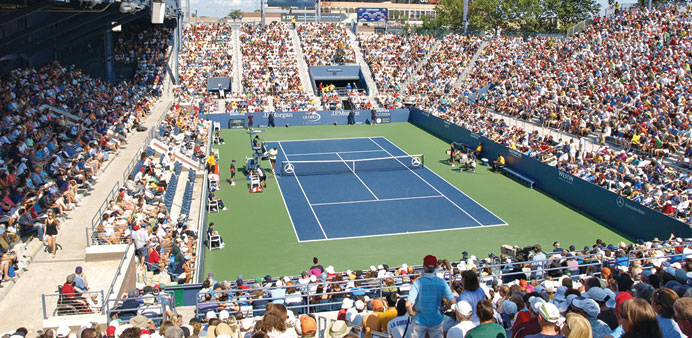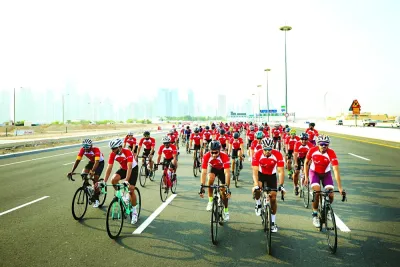One of the coolest places to watch a tennis match in the world, with a history as inimitable and quirky as its unique atmosphere, is set to make way for progress.
By Les Carpenter in New York/theguardian.com
Soon after the US Open, bulldozers will crawl through the tennis centre’s gates and begin trampling one of tennis’s last great places. The Grandstand is about to die.
At a glance, the Grandstand might not look like much in the kingdom of concrete and brick that the Open’s grounds have become. It is the shabby interloper in a corporate village designed first to siphon as many bills as possible from your wallet and second to feature tennis. The Grandstand does not offer farm-to-table concession huts or Ben & Jerry’s shops. You can’t gaze at Mercedes sports cars or Citizen watches as you stroll its corridors.
But if you love tennis, if you love the feeling you can almost touch a player as they serve, hearing them breathe and listening the pop of ball on racket as loud as firecrackers then the 6,000-seat stadium is heaven.
The seats are that close, the court that small, the pitch of the bleachers that steep. It is the most intimate of all the Open’s venues—a place where player and fan feel as one.
“The atmosphere is great, the crowd is amazing,” French player Jo-Wilfried Tsonga said after he played his final Grandstand match early in the tournament. “You can feel the air and the wind as it blows through. It’s one of the nicest courts I’ve ever played on.”
By next year’s Open it will be gone. In many ways it never seemed to fit, tucked up against the east side of the old main stadium, Louis Armstrong Stadium. Even in Armstrong’s glory days, the Grandstand was bathed in the shadows created by Armstrong’s then giant press box.
Many of Armstrong’s exits spilled onto catwalks and stairwells that overlooked the Grandstand and the bustle of fans mixed with the screech of wheels on track in the No 7 subway yard just outside made the court feel very much like New York’s tournament.
The USTA is tearing down the Grandstand to build a sliding roof on top of Armstrong Stadium. Sliding roofs are a good thing for fans who spend hundreds of dollars to watch matches. They are also good thing for television networks who pay millions to broadcast those same matches. But the sliding roof will take away the last unique thing about the Open’s grounds. It will also take away history.
Long before there was tennis at Flushing Meadows there were two Worlds Fairs. The second of those fairs, in 1964, was a celebration of innovation in mid-century America.
The grounds were filled with exhibits with names like Futurama, Magic Skyway and Tomorrow-Land. Much of the fair’s infrastructure, like all of New York City’s infrastructure in the first two-thirds of the 20th century was controlled by the city’s parks commissioner Robert Moses. And in the middle of the fair, Moses wanted a stadium.
The stadium—shaped like a long rectangle—seated anywhere from 15,000 to 20,000 people depending on whom you ask. It was built for the fair at the end of a boardwalk bridge to the 7 train and it was to compliment the much larger baseball park, Shea Stadium, several hundred yards away. Singer, the sewing machine company, bought the naming rights and the stadium in the fair was called the Singer Bowl.
“The Singer Bowl was one of the things that was built for the World Fair that was meant to be permanent,” said Joseph Tirella, the author of Tommorow-Land: The 1964 World’s Fair and the Transformation of America. “That means it was meant to stay.”
Which in a way it has. In 1977 half of the Singer Bowl was destroyed to accommodate a new stadium named after Louis Armstrong that would serve as the new home of the US Open. The other half of the Singer Bowl was repurposed as the Open’s Grandstand.
A lot more than tennis has happened in front of those seats. On the Fair’s opening day, President Lyndon Johnson gave a speech inside the Singer Bowl. It was five months to the day of his predecessor John F Kennedy’s assassination.
The country was still jittery. After Johnson spoke inside the stadium he went outside where he was accosted by the first great Civil Rights protest that featured aggressive, shouting college students, Tirella said.
His words were drowned out by the initial roar of 60s agitation.
That summer, three US Olympic teams—boxing, judo and wrestling—held their trials for the Tokyo Olympics in Singer Bowl. The most memorable of these was the heavyweight championship match in which Buster Mathis Sr beat Joe Frazier on points to earn the Olympic spot. Not long after, Mathis injured his hand, Frazier replaced him, won the gold and became a professional star.
In the years after the Olympics, Singer Bowl became a concert venue. The Doors, The Who and Jimi Hendrix all played there as did Led Zeppelin. Then came tennis and the grounds that changed over the decades from the people’s fair to a millionaires’ playpen.
In its second life the remaining half of Singer Bowl has hosted every major tennis player of their time. Those who didn’t play many matches on its court still used it to warm up for big night matches in Armstrong. The lucky fans who happened to stumble through its gates at the right time would get the treat of watching Jimmy Connors or Andre Agassi warming up, closer than they could get anywhere else.
Now it is doomed. The new Grandstand is rising on the other side of the tennis grounds. It looks like a bigger version of many of the center’s other courts. It will not be intimate. It will not be unique. It will not have LBJ, Joe Frazier or Led Zeppelin It will be just another court at just another tennis tournament.
And the last piece of the World’s Fair will be gone from the tennis center’s grounds.



